Meteor Crater
About 50,000 years ago, a rock the size of a large office building whipped into Earth’s atmosphere, sizzled on down, and spanked into what would become northern Arizona. An explosive event transpired, equivalent to about 20,000 megatons of nuclear-bomb-scale force, and a crater was created in the ground. It was roughly 600 feet deep, nearly a mile across, and about 2.5 miles around the rim.
Fast forward to today. This crater was never on “public land”, and has become a national treasure which is privately owned. The circumstances have resulted in a fortuitous situation. Far from any level of crass commercialism, the visiting facility is nicely architected and crafted into the surrounds; the prices are reasonable; the staff is well-educated, courteous, and helpful.
From a few miles north, the Crater rim sticks slightly above the surrounding terrain. It looks like little more than a distant ridge-line.
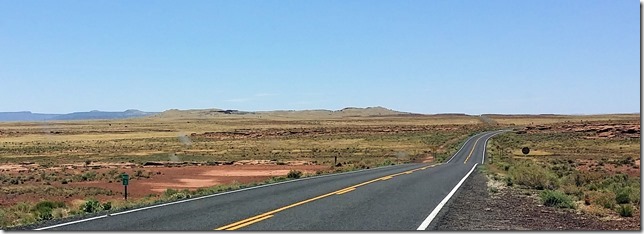
But an aerial shot really gives a sense of the real magnitude of the Crater.
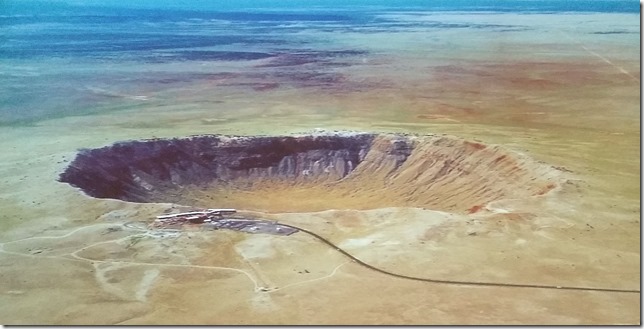
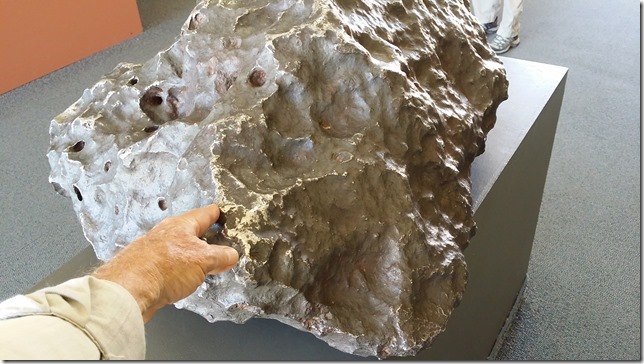
Picture a chuck of iron and stone that looks generally like this, but is the size of your office building, about 150 feet wide. Now visualize it sailing along at about 40,000 miles per hour and plunking down in the middle of the desert. That would get your attention.
Recently, a modern video has been crafted, and it alone is worth a visit to the Crater. Great graphics, and an excellent visualization of the impact and its effect on the Earth’s crust, are portrayed – – along with interesting history, geological, and cosmological aspects of meteorites and crater formation.
After using the Crater to understand better how impact-craters are made (and discovered), nearly 200 more craters were identified world-wide. Here are the currently known (red-dot) locations in North America and Europe.
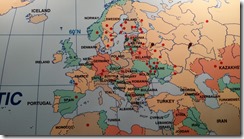
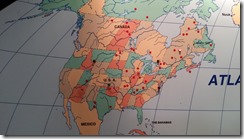
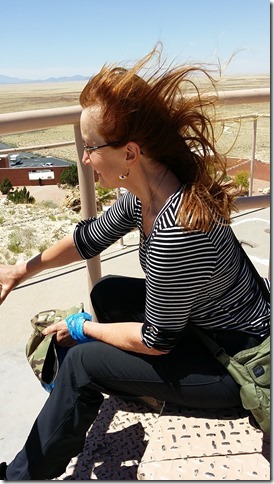 Along with the Crater, we were also subject to the local wind conditions, which were impressive to say the least. The Crater tends to “boil” any passing air currents, and the 25-knot prevailing winds were whipped into a frenzy of 50- and 60-knot furies that could easily have knocked us off our feet. Hanging on to the bannisters and pathway rails, we clearly understood the staff’s decision to close the Rim Trail. It was truly a dangerous day. We’ll come back some time to hike the 2.5 miles around the rim.
Along with the Crater, we were also subject to the local wind conditions, which were impressive to say the least. The Crater tends to “boil” any passing air currents, and the 25-knot prevailing winds were whipped into a frenzy of 50- and 60-knot furies that could easily have knocked us off our feet. Hanging on to the bannisters and pathway rails, we clearly understood the staff’s decision to close the Rim Trail. It was truly a dangerous day. We’ll come back some time to hike the 2.5 miles around the rim.
We learned that a couple of private pilots flew a Cessna 150 into the Crater in August 1964. The high altitude, high temperatures, and high weight (just refueled) of the aircraft caused them to be unable to climb out of the Crater. They circled many times, but at 1/2 mile diameter, the turns were very tight; eventually, the tiny plane stalled and crashed. Both pilots survived, and the pilot-in-command (John Kidd) went on to a lasting career flying 747’s for American. Lucky guy.
The science of early times was not very accurate; it was believed that the meteorite which blasted the Crater was 80% of the Crater’s size, and pure iron. Searches, drilling, and mining went on unsuccessfully for more than 25 years. Fortunately, the Crater is little marred for all the efforts. In fact, the remains of the plane crash were eventually stashed away in one of the old mine tunnels.
Here’s a shot from the wiki (Tsaiproject, GNU license) showing the expanse of the crater from the upper deck of the observation area. Pretty impressive.


Comments
Meteor Crater — No Comments
HTML tags allowed in your comment: <a href="" title=""> <abbr title=""> <acronym title=""> <b> <blockquote cite=""> <cite> <code> <del datetime=""> <em> <i> <q cite=""> <s> <strike> <strong>